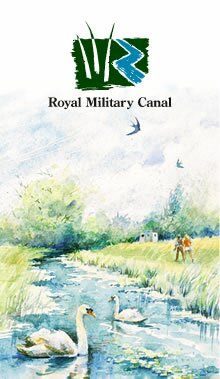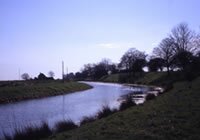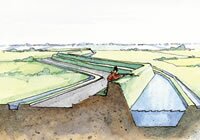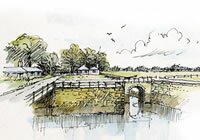

A kink in the canal

Artist: John Cann

Iden Lock, artist: John Cann

Artist: John Cann
28 Facts about the Royal Military Canal - one for each mile of its length.
- The Royal Military Canal is 28 miles long, running from Seabrook in Kent to Cliff End in East Sussex.
- It is the third longest defensive monument in the British Isles after Hadrian?s Wall and Offa?s Dyke.
- The canal was built in anticipation of a Napoleonic invasion. Napoleon had his armies massed on the shores of France waiting for the moment to invade. He also had some of his armies up his sleevies!!
- The Royal Military Canal was the third line of defence after the British Navy and a line of Martello towers stretching from Folkestone to Eastbourne.
- The canal has ?kinks? all along its length. This is a defensive measure, allowing troops to fire along the canal if invaders tried to cross.
- The first sod of the canal was dug on 30 October 1804 at Seabrook.
- The canal was originally designed to be 19 metres wide and 3 metres deep. But....
- Due to pressures of time and spiralling costs the canal was dug to only half its intended width and depth in most places.
- 22.5 miles of the canal were dug by hand, the remaining 5.5 miles are made up of the River Rother and River Brede.
- As well as stopping Napoleon it was hoped that the canal would hinder smuggling which was a serious problem on the Romney Marsh.
- Iden Lock was completed in 1808 and linked the Royal Military Canal with the River Rother. The original buildings - the officer?s house and the soldier?s barracks - can still be seen today.
- The canal took 4.5 years to complete.
- Why has the canal never been stolen? Because it has Iden Lock!!!
- The canal cost £234,310 to complete - a huge amount in Georgian England.
- The Royal Military Canal is one of two canals that were entirely state funded, the other being the Caledonian Canal.
- On his Rural Rides of 1823 William Cobbett dismissed the canal as a great military folly and a waste of public money; he was much more impressed by the Romney Marsh sheep.
- In order to recoup some of the money spent on the canal, it was opened for public use and tolls were charged to take barges on the canal...
- They also tried to sell the water as perfume - Canal Number 5!!!!
- A favourite food of the men that worked the barges was the onion bahji!!
- The last toll-paying barge travelled through Iden Lock on 15 December 1909.
- The last barge was called ?The Vulture?.
- During particularly cold winters the canal would freeze, and it was possible to ice skate all the way from Iden Lock to Seabrook.
- The canal is vital for irrigation and drainage on the Romney Marsh.
- On the Romney Marsh, the canal was affectionately known as ?Mr Pitt?s Ditch?.
- It is still possible to take non-powered boats on the canal today.
- The canal is a fantastic home to lots of wildlife, including Laughing frogs, emperor dragonflies, kingfishers and the majestic mute swan.
- Parts of the canal are a Site of Special Scientifc Interest (SSSI). The remainder of the canal is a Local Wildlife Site.
- Where do kingfishers keep their money? In the canal banks!!